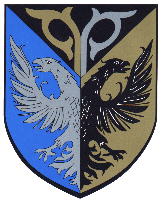Frisange: Difference between revisions
Jump to navigation
Jump to search
Knorrepoes (talk | contribs) (Created page with '{|width="100%" style="color:black; background-color:#ffffcc;" |width="15%"|50 px|left |width="70%" align="center" |'''Heraldry of the World<br>Civic heral…') |
Knorrepoes (talk | contribs) m (Text replace - "crozier" to "crosier") |
||
| Line 12: | Line 12: | ||
The arms were granted on August 18, 1981. | The arms were granted on August 18, 1981. | ||
The two | The two crosiers represent the abbeys of Echternach and of St. Maximin in Trier, who both had most of the territory in possession. The silver eagle is derived from the arms of the Lords of Hellange, who oroginated from the village of the same name in the municipality. The black eagle is derived from the arms of the Aspelt family from the village of the same name. | ||
[[Literature]] : Loutsch, J-C. et al.; Armorial communal du Grand-Duché de Luxembourg, Fisch, Luxembourg, 1989, 331 p. | [[Literature]] : Loutsch, J-C. et al.; Armorial communal du Grand-Duché de Luxembourg, Fisch, Luxembourg, 1989, 331 p. | ||
Revision as of 10:16, 10 March 2011
| Heraldry of the World Civic heraldry of Luxembourg |
FRISANGE
Origin/meaning :
The arms were granted on August 18, 1981.
The two crosiers represent the abbeys of Echternach and of St. Maximin in Trier, who both had most of the territory in possession. The silver eagle is derived from the arms of the Lords of Hellange, who oroginated from the village of the same name in the municipality. The black eagle is derived from the arms of the Aspelt family from the village of the same name.
Literature : Loutsch, J-C. et al.; Armorial communal du Grand-Duché de Luxembourg, Fisch, Luxembourg, 1989, 331 p.

